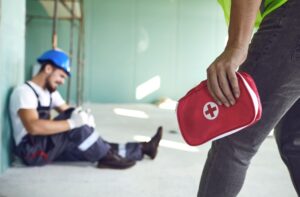Working in construction can sometimes be dangerous, and accidents at the worksite are not uncommon. It’s crucial for workers to have basic first aid knowledge, empowering them to respond effectively to emergencies and potentially save lives. This article highlights five essential first aid skills that every construction worker should be familiar with, enabling a swift response to common on-site injuries, such as cuts, burns, and fractures.
Understanding these vital first aid skills will not only enhance the overall safety of the construction workplace but also give workers the confidence to take action in the face of emergencies. Equip yourself and your team with the right knowledge to support each other in moments of need and contribute to an overall safer work environment in the UK construction industry.
1. Attending to Cuts and Lacerations
Injuries such as cuts and lacerations are relatively common on construction sites, given the nature of the work and the tools used. Knowing how to treat them is vital. Follow these steps in the event of a cut or laceration:
Assess the Severity: First, determine the severity of the injury. Small cuts can typically be treated on-site, whereas severe lacerations may require professional medical attention.
Stop the Bleeding: Apply pressure to the wound using a clean cloth or dressing until the bleeding stops. If blood soaks through the first cloth, place another cloth on top and continue applying pressure.
Clean the Wound: Clean the wound gently with water or a saline solution to remove dirt and debris.
Cover the Wound: Use a sterile adhesive dressing to cover the wound, ensuring it is secured but not too tight.
Be vigilant for signs of infection, such as redness, swelling, or heat, and seek medical attention if needed.
2. Treating Burns and Scalds
Construction workers are often exposed to heat sources that pose a risk of burns or scalds. Immediate and appropriate first aid is essential for treating these injuries:
Cool the Burn: Hold the affected area under cool (not ice-cold) running water for at least 10 minutes or until the pain subsides. Alternatively, use a cool, wet cloth if running water is unavailable.
Remove Constricting Items: Gently remove any jewellery or clothing close to the burn site, but do not remove clothing stuck to the burn itself.
Cover the Burn: Apply a clean, non-stick dressing (such as cling film) to the burn, taking care not to wrap it too tightly.
Monitor and Manage Pain: Over-the-counter pain medications can help manage pain as required.
For severe burns, seek immediate medical assistance.
3. Treating Fractures and Sprains
Construction sites pose various hazards that may lead to fractures or sprains. Quick and effective first aid can alleviate pain and prevent further injury:
Immobilise the Injured Area: Keep the injured limb as still as possible to prevent further damage. Use a makeshift splint if necessary to limit movement.
Apply Cold and Compression: Apply a cold pack or ice wrapped in a cloth to the injury for 10-15 minutes at a time. This helps reduce swelling and pain. Utilise an elastic bandage to apply compression, but not too tight, as that might impede circulation.
Elevate the Injured Area: If possible, elevate the limb above the level of the heart to minimise swelling.
Seek medical attention for proper diagnosis and treatment.
4. Managing Choking Incidents
Choking can be a life-threatening emergency on construction sites. Swift and appropriate first aid is crucial to save a choking victim:
Encourage Coughing: If the person can still breathe and cough, encourage them to keep coughing to dislodge the object.
Perform Back Blows: Stand behind the victim, placing one hand on their chest for support. Deliver up to five sharp back blows between their shoulder blades using the heel of your other hand.
Perform Abdominal Thrusts: If back blows fail, perform up to five abdominal thrusts (Heimlich manoeuvre). Stand behind the victim, wrapping your arms around their waist. Place a closed fist just above their navel and grasp it with your other hand, then pull sharply inwards and upwards. Repeat until the obstruction is cleared or the victim becomes unconscious.
If the person falls unconscious, commence CPR and call for emergency medical assistance.
5. Proper Use of Personal Protective Equipment (PPE)
While not a direct first aid skill, proper use of Personal Protective Equipment (PPE) significantly reduces the risk of injury on construction sites. Construction workers should be familiar with the PPE requirements for their roles, including wearing safety helmets, protective gloves, and steel-toed boots.
Understanding how to select, use, maintain, and dispose of PPE correctly is essential for workplace safety. Moreover, by effectively implementing a safety-first culture, construction workers can greatly reduce the risk of accidents, making first aid knowledge crucial but less frequently required.
By mastering these critical first aid skills, construction workers can contribute to a safer work environment and ensure the appropriate response in case of emergencies. Investing time and resources in first aid training for your workforce helps protect both the workers themselves and the overall integrity of your construction projects.
First Aid Skills as a Cornerstone of Construction Site Safety
Equipping construction workers with essential first aid skills is a vital component of promoting safety and injury prevention on UK construction sites. From treating cuts and burns to addressing choking incidents, these skills enable prompt and effective responses to emergencies, ensuring the well-being of your workforce.
Are you ready to elevate your team’s first aid knowledge and competence? Discover our range of first aid courses in Edinburgh designed specifically for the UK construction industry. By investing in first aid training, you not only safeguard the health of your workers but also contribute to a safer and more efficient work environment for all. Let’s work together to create a safety-first culture that benefits everyone in the construction industry.




